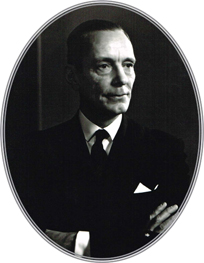


![]()
ONLINE


Chauncey Devereux Stillman
The Legacy of an Extraordinary Man
Chauncey Devereux Stillman held strong convictions about life, art, nature, and religious faith, and he acted on them.
A gentleman’s gentleman born into wealth, Stillman possessed a keen, active intelligence and a wide range of interests including history and literature, coaching, land and water conservation, and classical gardens. In June 1938, these pursuits led him to establish the Homeland Foundation, whose primary asset became the incomparable Wethersfield.
Stillman was the grandson of James Stillman, who was President of what now is Citigroup. James Stillman had three sons and two daughters. The daughters married William Rockefeller’s sons. One of James’s sons was Charles Chauncey Stillman, Chauncey Devereux Stillman’s father.
Raised a Protestant, Stillman converted to Catholicism in his mid-40s. Like every decision in his life, it was a careful, thoughtful one. “In 1952, I joined the Catholic Church after three decades of deliberation,” Stillman said. “Thus with destination known, charts and fare provided, and company too, I look forward cheerfully to the remainder of the voyage.” Stillman’s Catholic faith deepened in the succeeding years and became a touchstone for the charitable and cultural endeavors that were to absorb his life.
Homeland was created for purposes that reflected Stillman’s specific philanthropic interests including “to display art and period furniture; to sponsor religious charitable, scientific, and literary programs; to use for cultural activities; public outdoor recreation and scenic enjoyment; protection of natural environmental systems; conservation, cultural, intellectual, religious, and recreations purposes; preservation of natural wildlife; and to make other contributions and gifts, but only if made for exclusively public purposes.”
Stillman led Homeland until his death on January 24, 1989, when E. Lisk Wyckoff, Jr., who was designated by Stillman as President of its Board of Trustees, took over. Also, at the time, Stillman made his bequest of the Wethersfield Estate and much of his personal art collection to the Homeland Foundation, while leaving his other assets to his immediate family. Following Wyckoff’s death on November 26, 2012, his widow Elizabeth Wyckoff, who had known Stillman and had a longstanding familiarity with the business of the Foundation, was elected President of the Homeland board.
Mrs. Wyckoff shared the following: “Mr. Stillman was a man known for his precision, protocol, and punctuality. We had lunch in his apartment on many occasions, always arriving downstairs 15 minutes early. With the help of a stopwatch, our presence was announced exactly on time. The conversation invariably revolved around Mr. Stillman’s estate planning and the complicated process of giving money away. He was quite explicit with regard to the disposition of his assets. And he was specific with regard to his cautionary instructions about making grants. He stressed the importance of giving to organizations well known to his trustees and in the context of personal relationships within those organizations, in order to ensure the intended use of the gifts to the greatest extent possible.
As we departed, Mr. Stillman would hand me a bouquet of peacock feathers collected from his country estate and formally bid us farewell. It was an extraordinary encounter with an extraordinary man.”
In ensuing years, per Stillman’s wishes and under the farsighted leadership of Lisk Wyckoff, Homeland has made some extraordinary grants to a wide array of religious, aesthetic, and educational institutions, which directly reflected Stillman’s personal interests or the philosophies he upheld. In many cases, these gifts resulted in transformational change to the recipient organizations. Stillman’s religious faith and the themes of restoration and preservation were fundamental to the bequests Homeland made during his tenure.
Stillman was an avid collector of Renaissance art and passionate about art restoration. A leading example is a grant made to the Metropolitan Museum of Art, especially its sponsorship of the stunning 2005-2006 Fra Angelico Exhibit. The exhibit was the first comprehensive showing in the United States of the Italian Renaissance master’s artwork from throughout his career (1410 to 1455). Homeland’s support of the Fra Angelico exhibit resulted in the restoration of original Fra Angelico triptyches, whose parts had been separated and lost over the course of history.
Even though Stillman had passed away more than 15 years earlier, his religious faith was alive in Homeland’s gift, for Fra Angelico, known as the “angelic friar,” who was born Guido di Pietro in Florence, Italy, and became a Dominican monk. He was beatified in 1984 by Pope John Paul II and declared the patron of painters.
The foundation’s support of religious art extended to Rome, where Homeland made a series of grants to the Vatican Museums over two decades. In 1998, under the leadership of Mr. Wyckoff, Homeland made a grant to the Vatican Museum for the restoration of the panel in the Sistine Chapel entitled “The Journey of Moses,” painted by Pietro Vannucci in the 15th century.
The foundation has supported many educational institutions through funding programs related to architecture, Catholic studies, creative expression, ethics, music, and theological inquiry. These efforts extended into the heart of New York City with grants to the Inner City Scholarship Fund, providing education for more than 650,000 students.
In accordance with Stillman’s passionate vision, Homeland Foundation has supported a variety of significant charitable undertakings over the years with major institutions. Today, under Mrs. Wyckoff’s leadership, the foundation will focus on the beautiful Wethersfield estate and its interface with the surrounding community.•